Food for thought
- Coming up with ideas is easier once you learn to trick your mind
- Many creatives use a tried & true Creative Process
It’s your wife’s birthday – but you don’t remember until you’re finishing up your second margarita. You drop some cash on the bar and wave goodbye to your coworkers. When you get home, your wife is waiting. She is NOT happy.
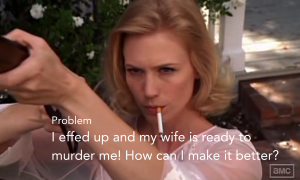
Good thing there’s a bodega around the corner that has flowers.
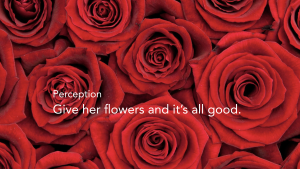
You grab a small bouquet of whatever looks freshest. Problem solved, right? Not so fast. How do you know the flowers you picked will smooth things over? Is the bouquet is too small? Are the flowers the kind you’d give grandma – or the woman of your dreams?
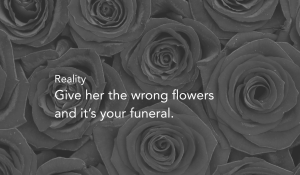
The truth is, if you give the wrong flowers to someone who’s already mad at you, it might make things worse. Enter the Society of American Florists (SAF).

The SAF, which supports florists of all sizes, came up with an idea to help forgetful husbands in their hour of need. A banner florists can hang in their shops during key times of the year like Valentine’s Day, Mother’s Day – or year round for you know… birthdays.

The SAF provides this physical banner plus Facebook ad graphics along with the following advice.
Capitalize on his guilt. Help Romeo out of the doghouse with the Society of American Florists’ “Exactly How Mad Is She?” graphic. When posting it, include a link to a page on your website featuring larger, more expensive designs and suggest some add-ons to go with the flowers (he’s feeling guilty, remember?).
I can easily imagine extending this idea to other media platforms. For example, an Instagram flower-o-meter quiz type thingy that asks how mad your wife is on a scale of 1-5. Then does a quick calculation and shows you exactly which amount and type of bouquet you need to get you out of hot water. There could be different versions depending on whether the injured party is your spouse, mother, sibling, friend, co-worker. You could add filters like how long you’ve been dating, and of course how much money you have to spend. You can click through to have the recommended floral solution solution delivered within the hour.
What other content could you create based on this idea? YouTube pre-roll ads? A florist pop-up experience complete with a therapist on hand?
How did the SAF come up with this idea? I can’t be sure. But I do know this: your chances of coming up with ideas are much better if you use a Creative process that’s proven to yield results. Below is just one example of a Creative process that
The Creative Process
- Step 1 – Saturation
- Step 2 – Procrastination
- Step 3 – Sleep
- Step 4 – Ideation
The Creative Process I’m about to share works for me, as well as for some filmmakers, painters, songwriters, and screenplay writers, stand-up comics – basically artists of all kinds. But it might not work for you. I’m going to share it anyway because the number one rule of ideation is: don’t be afraid to share your ideas. What might seem like genius might be idiocy to someone else. But you’ll never know if you don’t put it out there.

Step 1, Saturation, is when you gather as much information as possible. You do research, visiting the brand website and reviewing the brand’s social feeds. You read any and all materials you can get your hands on – including anything you’ve been given: client research, the brief, product reviews, etc. You immerse yourself in the brand, becoming an expert overnight. When you’re at the point that you don’t think your brain can absorb any more, when you’re truly saturated, it’s time to stop.

It’s crucial to become knowledgeable about a brand you’re being paid to represent; to become a brand steward. After all, your client, the brand, is paying you and your ad agency to advise them on the best way to reach and activate their consumer. So let’s assume you’ve done your homework. You’ve gathered so much data and information that your brain just can’t soak up any more. Time to move on to Step 2.
You can’t skip Step 2 either. It is a very important step. Just gathering a bunch of information and trying to go straight to the ideas is not likely to yield much. Because you haven’t allowed anything to percolate. You need time to let everything sink in. You have to let your subconscious synthesize what you’ve taken in. You’ve got to do Step 2 – which is to go do something else. Anything else.
There are many theories about how the creative brain works. Here’s mine. Each of us has a subconscious mind. That subconscious contains islands of creativity. In Step 2, you dump a bunch of information on their shore, without a lot of backstory. Then you walk away. You go do something else. I do my best procrastinating while walking in Fort Tryon Park (pictured below), near where I live uptown in Washington Heights. When I’ve taken in a bunch of information, feel saturated and just can’t think about it anymore, I could clean the cat’s box, doom scroll on Instagram, or grade exams. But walking in the park is my favorite way to do Step 2 – which is to Procrastinate.

Creative Process Step 3 – Sleep
Now it’s time for Step three. This is one of the most challenging steps for students because during the semester they rarely get enough sleep. Right? But sleep is where students’ islands of creativity really get to work. Chances are they got started as soon as you start taking information in. You’ll try to stop yourself from jumping ahead to Step 4 – to coming up with ideas – but your subconscious will start coming up with something. While you sleep your islands of creativity will fight it out amongst themselves to come up with something better even better.

They’ll battle it out – if you let them – and come up with lots of different ideas while you sleep. But if you don’t sleep, they don’t get to fight it out. Ever hear the saying: sleep is the next big thing? When it comes to the creative process, it really is.
So let’s say you somehow managed to get some decent sleep. Your islands of creativity were hard at work while you snoozed. They were busy planting seeds of ideas. Those seeds are most likely to grow like crazy under the right conditions; in an idea chamber. What’s an idea chamber? It’s an actual location. But it’s different for everyone. Your idea chamber is the place where you’re most likely to come up with ideas. Lots and lots of ideas.
My idea chamber is the shower. So you could say that the magic happens in the bathroom. (Much to my husband’s chagrin.) Picture this: I’m working on a project; I’ve gathered a ton of information; I went for a long walk and had a good night’s sleep. The next morning, I get in the shower and once the water is turned on, the ideas start to flow.
Other people report that their idea chamber is their car. The ideas start to come when they’re driving. Or when they’re cooking. Or when they’re giving a talk. In many, many instances the ideas start to come when you cannot use your hands. What’s going on here? Your brain is playing a trick on you. But if you understand this process, you can turn the tables and trick your brain.
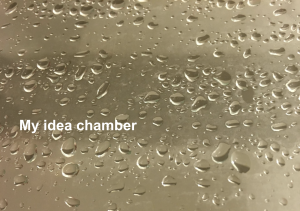
I’ve been aware of my creative process for decades. So once I’ve gone through Steps 1-3 and find myself in the shower, I’m ready for what’s next. I keep a sharpie and sticky notes close by. Yes, that means I’m opening the shower and dripping water everywhere. But I’m able to capture the ideas. I write them down as fast as they come and stick them to the mirror. Afterward when I’m dry, I look over what I wrote and start to group the ideas. Often those ideas beget more ideas.
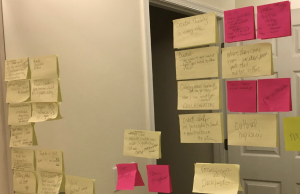
It’s great to know where your idea chamber is and how to use it. However, no job I’ve ever had came with a shower. Just a cubicle or an office. Sitting at a desk in an office building is not the best way for me to come up with ideas. Maybe it works for you. But honestly I don’t know a lot of creative people who when given the choice would say give me a desk, some bad lighting, and noisy co-workers and whammo I’m a genius!
Where is your idea chamber? I have no idea. You might not either. It’s up to you to identify it. Is it on the subway? The classroom? A bench in the park? Is it when you’re walking your dog? When you’re driving? Is it in a museum? Or at your favorite coffee spot? Do you get ideas when you’re biking? When you’re swimming?
Here’s part 1 of your homework assignment: Find your Idea Chamber. Where stuff comes to you? Is it on the bus? Is it when you’re eating lunch? Is it when you’re drinking coffee? Is it when you’re in the shower? Is it when you’re playing with your dogs find your own idea chamber and that way you don’t know when you need to come up with ideas.
You need to pay attention to where you go; to where you spend your time and find where is the place that you’re most likely to come up with lots of ideas. Where ideas germs of ideas start coming to you. They don’t have to be fully formed. You just need to be aware so you can trick your mind and are prepared to be able to capture those ideas.
Part 2 of your Homework is to try the Creative Process. Use it to come up with some ideas for your Poo-Pourri campaign. If it doesn’t work for you, try any other process so that when you know you need to come up with ideas, you can trick your mind so that those ideas will come. Do all the steps. And let me know what happens.
Key Takeaways
The Creative Process really does work. But you have to keep using it. Come up with one set of ideas. Work on them. Then rinse and repeat throughout the development of a campaign. You do this over and over and over again. You don’t just gather information once and stop. You gather some more information you go back to the social feeds you look at another YouTube video, you read more consumer reviews? You go do something else again. Okay, you sleep, find your idea chamber the germs of ideas will come.
- Step 1 – Saturate your brain until you just can’t absorb anymore.
- Step 2 – Go do something else. Procrastination is a very important part of the creative process.
- Step 3 – Sleep well and deeply.
- Step 4 – Find your idea chamber wherever it is, and be ready for the germs of ideas to come.
